The control volume is described along with a lot of examples, explanations, diagrams, types, characteristics. Let’s explore!
Control Volume Basics
Let’s learn Control Volume!
- Have you made tea at any time?
- Or have you seen your mother or father make tea?
When we make tea, we put some water along with some ingredients in a kettle and put it in the oven. After a couple of minutes, due to heat from the oven, water starts boiling and vapor comes out from the kettle.
This entire kettle is having a volume, in which water takes heat energy from the oven and water vapor or mass is released to the atmosphere through its neck. This volume is simply known as Control Volume.
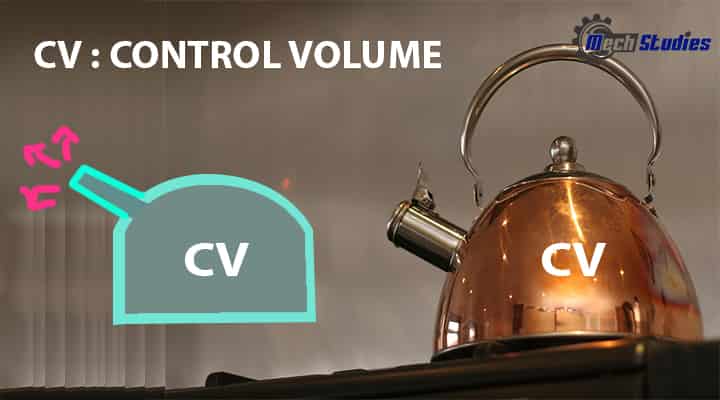
What is Control Volume? Definition
In thermodynamics, the control volume is a term that is related to the study of mass and energy balance for flowing systems. There are various kinds of systems we study and to know all details, the idea of the control volume is necessary.
Let’s see the definition of Control Volume! Control Volume is defined as the fixed volume over which mass can transfer in and out across its boundary. The surface which is bounded the control volume is called Control Surface. The knowledge of the control volume concept is essential to analyze,
- Various thermodynamic systems,
- Many thermodynamic problems,
- Making energy balance since it is facilitated to track the energy balances properly.
Understanding with Diagram
A sketch of a control volume along with a control surface is indicated. It is applicable for an open system only.
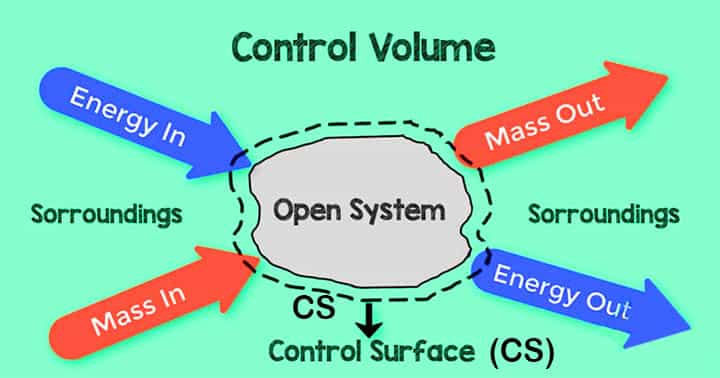
- Look at this sketch, here a red & blue arrow shows that mass & energy respectively can transfer to the system and from the system.
- CS is a control surface that separates control volume from the surrounding.
In case of a closed system, we all know that no mass transfer from or to the system but energy transfer can happen. Here, we say control mass instead of the control volume.
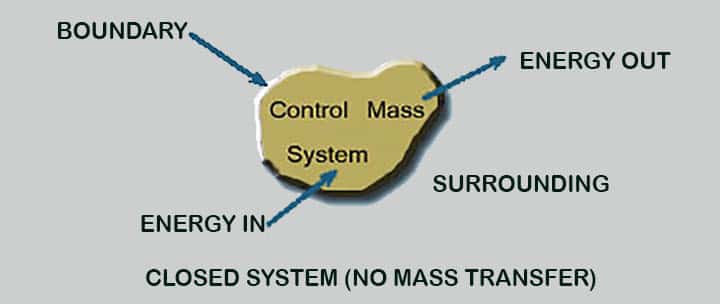
Look at this sketch, here no mass or energy flow to the system or from the system. Like, control volume, here also control surface separates control mass from the surrounding.
Control Volume Types
Based on the deformity, the control volume is classified into two categories,
- Non–deformable
- Deformable.
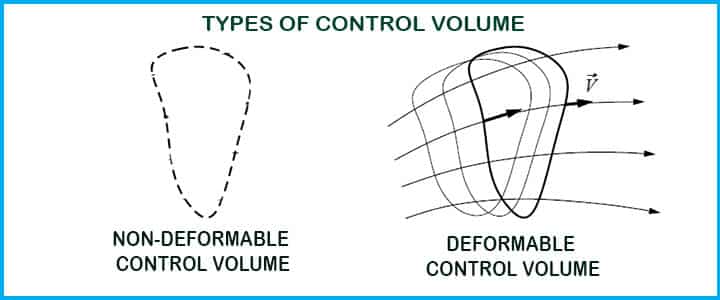
Non–deformable control volume
- This is fixed with respect to one specific co-ordinate.
- This reference coordinate may in motion with respect to another co-ordinate.
Deformable control volume
- In this case, the boundary is in motion.
Characteristics of Control Volume
Control Volume has the following characteristics:
- It’s a definite volume specified in space.
- It has a fixed volume over which mass can transfer in and out across its boundary.
- It is also called an open system.
- It is bounded by the control Surface.
- It may be real or imaginary.
- The mass may or may not be constant within a control volume.
- The mas may or may not be accumulated within the control volume. However, we will consider in our study that no mass will be accumulated.
- Matter in a control volume can be changed with respect to time as matter enters and leaves its control surface.
- It can be non-deformable or deformable.
- It can be rigid also.
Choosing a Control Volume
The control volume is to chooses based on the followings,
- It is simply an arbitrary volume in which fluid flows.
- The volume can be fixed, flowing, non-deformable, or deformable.
- In order to solve all kinds of control volume problems, the idea of entropy balance, steady-state analysis, and one inlet one exit analysis.
Entropy Balance
We know that control volume means both mass and energy can transfer through the boundary. Let us take a control volume and which undergoes process 1-2, From the definition of entropy,
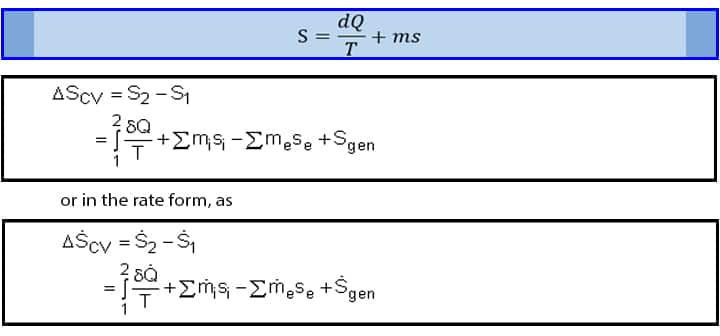
where,
- i – inlet
- e – exit
Hence, entropy change in a control volume = entropy transfer by heat + net entropy transfer by mass + entropy generation in the control volume
Difference between System and Control Volume
At a glance, it seems system and control volume is the same, however, there are some differences, as follows,
| Sl. No | Description | System | Control Volume |
| 1 | Mass & Energy Transfer | Open system is same as control volume, but in case of closed system, mass or energy is fixed | Control volume is always fixed, and mass or energy transfer happens from the system and to the system |
| 2 | Example | Piston cylinder arrangement | A jet engine, air compressor |
You can solve mathematical problem on it.
on it.
Example of Control Volume
Let us consider, a piston and cylinder arrangement for a closed system and a flowing liquid in an open system. Other examples are:
Explanation of a Control Volume and its use is illustrated for clearing the concept. We use the boiler to produce steam, and heat and the mass transfer happen here. So the boiler has a control volume. Further, it transfers to the turbine for energy output. In the turbine, it will have a control volume.
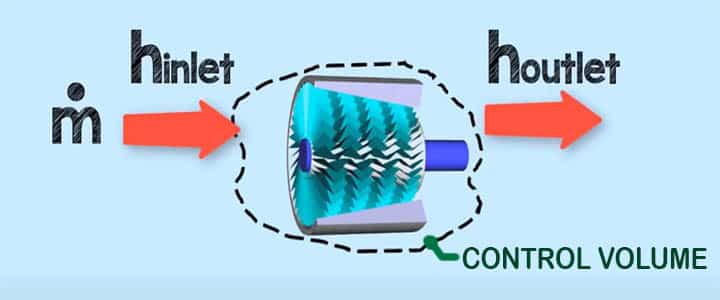
Example with Control Volume Calculation
Consider, a plate is fixed and a water stream is striking on it and got deflected at 90 deg. the angle on both sides.
- Velicity of water = 2.5 m/s.
- Water flow rate (mass flow rate) = 3 m3/s
- No external pressure is associated.
How do we calculate,
- Pressure force
- Body force
- Total force
Solution
- Since pressure is atmospheric in both the case, the pressure force is zero.
- The control volume is very small & body force due to the weight of gravity can be ignored.
- Total force = F = ρ x Q x (V1 – V2) = 1000 x 3 x (2.5-0) = 7500 N
Hence, Fx = 7500 N
Fy = 0
F = (7500, 0)
Special Note
The control volume is applicable for open system and control mass is applicable for closed system only. These control volume and control mass both are not the same, and study is essentials to solve the problem associated with thermodynamics.
Conclusion
Hope, the basic idea is cleared about control volume. Check out our a few interesting articles,

I have read so many posts about the blogger lovers however this post is really a good piece of writing, keep it up
Everything is very open with a very clear description of the challenges. It was truly informative. Your site is very helpful. Thank you for sharing!|
I don’t even understand how I finished up here, however I believed this put up was good. I do not understand who you’re but certainly you are going to a well-known blogger in case you are not already. Cheers!|